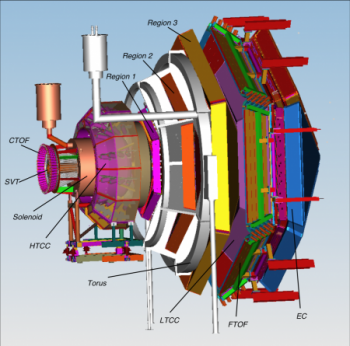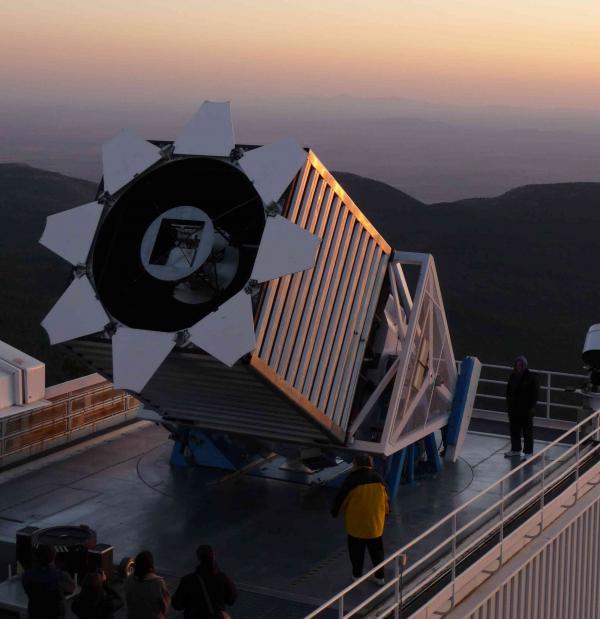As part of the new CLAS spectrometer project for the 12 GeV electron energy upgrade of the Jefferson Lab (USA) IRFU has been conducting R&D for more than 10 years to design and build a new generation tracker, using thin and flexible MICROMEGAS detectors that are now operating with the new CLAS12 spectrometer. After one year of installation, this tracker is operational and meets the expected characteristics with more than 95% detection efficiency and a spatial resolution of less than 100μm. After a dedicated data collection to measure the detector response, the new CLAS12 spectrometer is now collecting data for the DVCS physics experiment, where IRFU also participates and which objective is to measure the internal structure of the proton in three dimensions.
The exceptional success of the tracker project, that results from a close collaboration between IRFU's engineering and physics departments (DEDIP, DIS and DPHN), has been an example for other projects. Let us quote the LHC experiments for particle hunting, the muonic imaging of the pyramids, as well as a transfer of know-how to industry.
In ultra-relativistic heavy ion collisions at CERN's LHC accelerator, a new state of matter is formed: the quark-gluon plasma (QGP). It is a kind of very dense and hot "soup" containing only the most elementary constituents of matter. A few microseconds after the Big Bang, the Universe would have passed through this state. Because of the interactions between its constituents, the QGP flows like a fluid. At the LHC, interactions between constituents of the QGP are so strong that even objects as massive as the charmed quarks are carried away by this flow, as suggested by the measurement of the flow of the J/ψ (particle composed of a charm quark and its antiparticle) of ALICE during the first campaign of the LHC (see highlight 2013). This result has just been confirmed by the ALICE collaboration using data from the new LHC campaign (2015-2018). The precision obtained suggest the need of including new mechanisms in the theoretical models. The Saclay group played a key role in analyzing this data.
More than twenty years after the discovery of the acceleration of the expansion of the Universe, the nature of the physical phenomenon at the origin of this acceleration, called "dark energy", is still unknown. The current model of cosmology is based on general relativity as a theory of gravitation and establishes a theoretical prediction for the quantity of galaxies that form at a given period of the Universe. This cosmological parameter is called the growth rate of cosmic structures. It allows to test directly the gravitation theory at the scale of these large structures.
For the first time, the eBOSS multi-spectrograph mounted on the Sloan Digital Sky Survey telescope in New Mexico, allowed to measure this parameter from the distribution of spatial correlations of quasars. Quasars are among the brightest sources of light in the Universe and allow us to probe an era almost unexplored by this cosmological test, when the Universe was between 3 and 7 billion years old. The sample on which the analysis is based corresponds to 2 years of data collection and has already allowed the selection of more than 148,000 quasars. The measurements made confirm the validity of the model of cosmology based on general relativity and can also be used to constrain alternative theories of gravity.
The results were published in the Monthly Notices of the Royal Astronomical Society (P. Zarrouk et al, 2018).
The collaboration continues to acquire data with final analysis planned for the end of 2019, which will double the sample size. DPhP cosmologists are heavily involved in all stages of the eBOSS program, as well as in its successor, the DESI project located at the Kitt Peak National Observatory in Arizona, which is scheduled to begin data collection in 2020.
After more than 5 years of development, including 6 months of integration work of the 12,000 separate components to a complete cryomodule, the CEA-Irfu has just validated the technology of this complex system that reached the nominal ESS accelerating field in the 4 superconducting accelerating cavities.
At the limits of technology, this is the first time that such an intense accelerating field, maintained over such long pulse durations and with such high RF power, has been measured in superconducting cavities installed in a complete cryomodule.
This key step makes it possible to start the production phase of the 30 cryomodules that France is to deliver to the ESS research infrastructure, which will be operational in Sweden in 2023. This serial integration will begin in January 2019 under the supervision of Irfu with the contribution of the company B&S France and should be completed in 2022.





